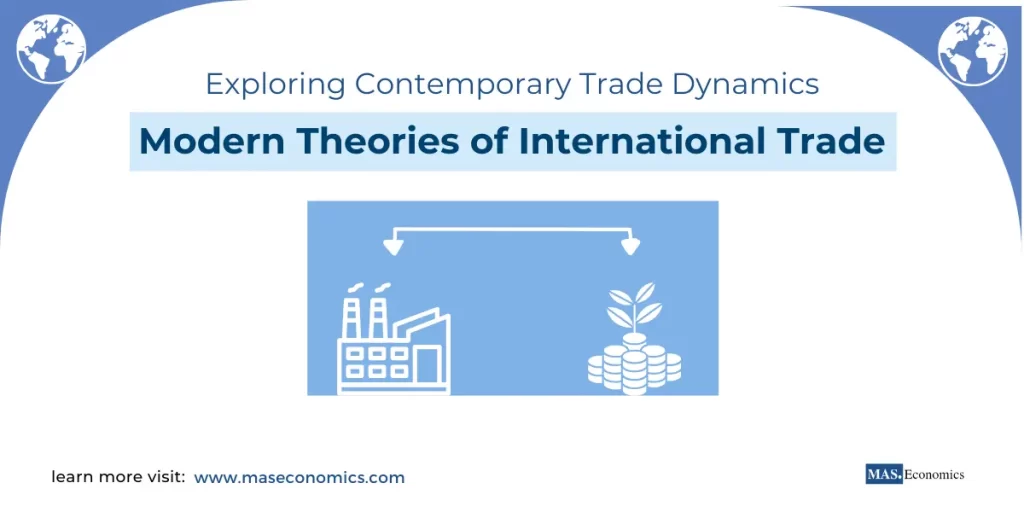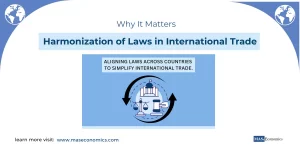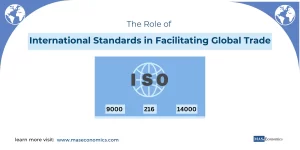The world of international trade today is complex and deeply interconnected, a far cry from the times when Adam Smith and David Ricardo first developed their groundbreaking theories. While their concepts of absolute and comparative advantage gave us the basics of why countries trade, modern theories of international trade have taken this understanding a step further. These contemporary models add nuance to how we think about the factors driving trade, making them particularly relevant in today’s global economy, where different countries interact under varied economic and technological circumstances.
The Heckscher-Ohlin Theory
One of the most influential modern trade theories is the Heckscher-Ohlin (H-O) theory, formulated by two Swedish economists, Eli Heckscher and Bertil Ohlin. Unlike earlier models that focused on productivity differences, the H-O theory emphasizes the importance of factor endowments—in other words, the resources a country has in abundance, such as labor, land, or capital.
The idea here is fairly straightforward: countries will specialize in producing goods that use their abundant resources efficiently. If a nation has a lot of capital, like machinery and infrastructure, it will tend to produce capital-intensive goods. Conversely, if a country is rich in labor, it will naturally specialize in labor-intensive goods. This leads to a natural pattern of trade based on what each country can produce most efficiently.
A Closer Look
To make the theory more concrete, let’s consider two countries, Country A and Country B. Suppose Country A is rich in capital and Country B is abundant in labor. Let’s say both countries can produce cars (which are capital-intensive) and textiles (which are labor-intensive). Now, here’s where it gets interesting. According to the H-O theory:
Country A, with its abundant capital, will find it easier and cheaper to produce cars because its capital resources are better suited for this kind of production.
Country B, with an abundance of labor, will focus on producing textiles because its labor costs are lower, making it more competitive in that market.
This leads us to a more detailed understanding of specialization and trade. Essentially, both countries benefit because they are not wasting resources trying to produce things that are costly for them. Instead, each one specializes in what it can produce more efficiently, and they trade to get the other product.
Explaining the Heckscher-Ohlin Equation
The H-O model can be represented with an equation that explains how the availability of resources affects production choices. Let’s break it down:
In this equation, \(P_{ij}\) represents the production of a good \(j\) in country \(i\). The term \(F_i\) stands for factor endowments (like capital or labor) in country \(i\), and \(R_j\) represents the requirements for producing the good \(j\). Essentially, this equation is saying that the level of production of any given good depends on the availability of the factors needed to produce it and how effectively those factors can be applied.
Imagine Country A with abundant capital, where \(F_{\text{Capital}}\) is high. If \(R_{\text{Cars}}\), which represents capital requirements for cars, is significant, then Country A is naturally predisposed to excel in producing cars because its available factors match the production requirements effectively.
Heckscher-Ohlin in the Real World
The H-O theory can be clearly observed in real-world examples. Germany is a great case in point. Germany has a significant amount of capital, which makes it one of the world’s leading producers of machinery and automobiles. Meanwhile, Bangladesh specializes in the textile industry due to its abundance of labor. This is why trade flows between developed and developing countries are often consistent with the H-O model—countries with capital export capital-intensive goods, while labor-abundant countries export labor-intensive goods.
Kravis and Linder Theory
While the H-O theory helps us understand the supply-side dynamics, it doesn’t fully explain why countries with similar resource endowments might still trade similar goods with each other. This is where the Kravis and Linder theory comes into play. Both Irving Kravis and Staffan B. Linder looked at trade from a different perspective, focusing more on consumer preferences and demand patterns.
Linder’s Hypothesis Explained
Staffan Linder proposed a theory that was fundamentally different from what was presented in the H-O model. His hypothesis centered around the idea that countries with similar income levels have similar consumer preferences. This similarity drives trade in similar products, leading to what we call intra-industry trade.
Let’s take an example involving luxury automobiles. Both Germany and Japan are high-income countries, and both have large markets for high-quality cars. According to Linder’s hypothesis, these countries will produce and trade cars with each other, despite having similar capabilities. It’s not that one country has an absolute advantage in car production—it’s that consumer preferences in both countries create a demand for variety that trade can satisfy.
In simple terms, while classical trade theories suggest countries will exchange entirely different goods, Linder’s hypothesis suggests that trade will also occur between countries producing similar products because of market demands. This helps explain why France and Italy export wine to each other despite both being great wine producers. Their domestic consumers want different types of wine, and variety drives this trade.
Kravis’s Contribution
Irving Kravis added another layer by focusing on what he called availability theory. Kravis argued that a country will import goods that are not readily available domestically. Here, trade is driven not just by costs and efficiency but by consumer demand and availability. For instance, countries that do not have a favorable climate for growing coffee, such as the UK, will import it, regardless of their resource base or technological capabilities.
Factor Price Equalization Theorem
The third modern trade theory we will discuss is the Factor Price Equalization (FPE) theorem, which was developed by Paul Samuelson. The FPE theorem suggests that international trade can lead to the equalization of factor prices—that is, wages and returns on capital—between trading nations.
How Factor Price Equalization Works
To understand this theory, think of it as an extension of the Heckscher-Ohlin model. Imagine two countries, Country X and Country Y. Suppose Country X has a surplus of labor, leading to low wages, while Country Y has a surplus of capital, leading to high returns on investment. In the FPE theorem, trade effectively replaces the need for factor mobility (i.e., the need for workers or capital to move across borders).
Let’s use a practical scenario involving Country X (labor-abundant) and Country Y (capital-abundant). Country X specializes in producing labor-intensive products like textiles, while Country Y focuses on capital-intensive products like heavy machinery. Through trade:
Country X produces more textiles, which increases the demand for labor, pushing up wages.
Country Y produces more machinery, which increases the demand for capital, raising returns on investment.
Through this mechanism, the difference in factor prices between countries (wages in Country X and returns to capital in Country Y) begins to narrow. The underlying assumption here is that both countries have similar technologies, allowing the factors to be used efficiently in either context.
A Mathematical Representation of the FPE
The FPE theorem can also be represented mathematically. If we denote \(w_i\) as the wage rate in country \(i\), and \(r_i\) as the rate of return on capital, then under certain trade conditions:
This equation essentially suggests that wages in Country X and Country Y will become comparable as they trade. The same applies to returns on capital. This result implies that, over time, differences in income distribution—wages for workers and returns for investors—can be reduced through the natural course of international trade.
Real-World Implications and Limitations of Modern Trade Theories
These modern theories have significant implications for international economics and policy-making. For instance, the Heckscher-Ohlin theory provides insights into why countries produce what they do based on resource availability. Meanwhile, the Kravis and Linder theory explains why countries trade similar products, particularly in high-income contexts. Finally, the Factor Price Equalization theorem helps to understand how trade affects income distribution, both within and between countries.
However, it’s important to acknowledge some of the limitations of these theories. The Heckscher-Ohlin model assumes that technologies are the same across countries, which is not always true in reality. Moreover, the Factor Price Equalization theorem hinges on assumptions like identical production technologies, which rarely holds. Even in highly developed countries, technological differences can significantly impact productivity, making full-factor price equalization an unlikely outcome.
Additionally, trade barriers like tariffs, quotas, and subsidies complicate these theoretical outcomes. For instance, countries may impose tariffs to protect domestic industries, which can prevent the equalization of wages and returns, thereby affecting income distribution differently than what the FPE theorem predicts.
Conclusion
The modern theories of international trade—including the Heckscher-Ohlin theory, the Kravis and Linder theory, and the Factor Price Equalization theorem—provide a deeper understanding of why countries trade and how they benefit from it. Unlike classical theories, which focus mainly on differences in productivity, these modern perspectives take into account a wider range of factors, including resource endowments, consumer preferences, and the implications of trade on income distribution.
FAQs:
What is the Heckscher-Ohlin theory, and how does it explain trade?
The Heckscher-Ohlin (H-O) theory explains international trade by focusing on countries’ factor endowments—resources like labor, land, and capital. Countries specialize in producing goods that utilize their abundant resources efficiently. For instance, a labor-rich country will export labor-intensive goods, while a capital-abundant country will export capital-intensive products.
How does the Kravis and Linder theory differ from traditional trade theories?
While traditional theories like comparative advantage emphasize differences in productivity or resource availability, the Kravis and Linder theory focuses on consumer preferences and demand patterns. Linder’s hypothesis states that countries with similar income levels have similar consumer preferences, which leads to intra-industry trade—where nations trade similar goods, such as luxury cars or wines, to meet consumer demands for variety.
What is the Factor Price Equalization theorem?
The Factor Price Equalization (FPE) theorem, developed by Paul Samuelson, suggests that international trade can reduce wage and capital return differences between countries. As trade increases demand for each country’s comparative advantage, wages and returns on capital converge across nations, even without the need for labor or capital to move between borders.
How does trade affect income distribution according to the FPE theorem?
The FPE theorem posits that through trade, countries with different resource endowments experience wage and capital return convergence. In labor-abundant countries, wages rise as trade increases demand for labor-intensive goods. Conversely, in capital-abundant countries, returns on investment rise as trade boosts capital-intensive production, reducing income inequalities between trading nations.
Can countries with similar resources still benefit from trade?
Yes. The Kravis and Linder theory explains that even countries with similar resources and technologies engage in intra-industry trade by exchanging differentiated products to meet consumer demand for variety. For instance, two high-income countries may both produce and trade cars, catering to consumers seeking diverse models and features.
How does the Kravis and Linder theory explain intra-industry trade?
The Kravis and Linder theory suggests that countries with similar income levels have overlapping consumer preferences, which drives trade in similar goods. This phenomenon, known as intra-industry trade, occurs when countries exchange similar products to meet consumer demands for variety—such as France and Italy trading different types of wine with each other.
What limitations do these modern trade theories face?
The Heckscher-Ohlin model assumes identical technologies across countries, which is rarely true in practice. The Factor Price Equalization theorem also relies on assumptions like free trade and identical production technologies, which are often disrupted by trade barriers such as tariffs and subsidies. These limitations can affect the applicability of the theories in real-world scenarios.
Thanks for reading! Share this with friends and spread the knowledge if you found it helpful.
Happy learning with MASEconomics




